
What is End to End Testing? Why is it Important?
December 11th, 2019
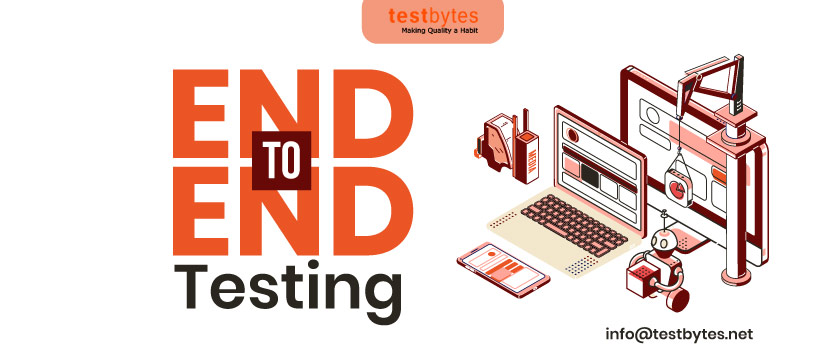
Testing is an important phase of the software development life cycle. The more regress and more extensive the testing is, the lesser are the chances of defects and software breakdown. The defects in the end products are not only because of the functional part of the application but can also arise because of the system and sub-systems integration, error in the back-end database, etc. As a result, you require the assistance of end to end testing
What is End to End Testing?
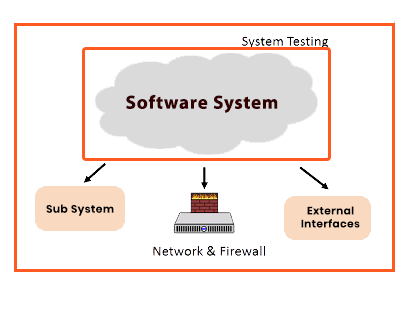
As the name suggests the process is used to tests the software from start to end.
E2E testing is also used for testing software that not only authenticates the Application under test but also validates its integration with external interfaces.
E2E can test batch/data processing from upstream/downstream systems. It is generally conducted after functional and System Testing.
To simulate real-time settings, it uses data and test environment. The process is called Chain Testing. It is conducted to test real-world scenarios like communication of the software with the network, hardware, database, and other applications. It also helps in determining the dependencies of software.
When to Apply End to End Testing
The process should only be conducted if there is a problem in the system or the output is not as expected. The team then has to record and analyze the data to define the origin of the issue.
End to End Testing Life Cycle
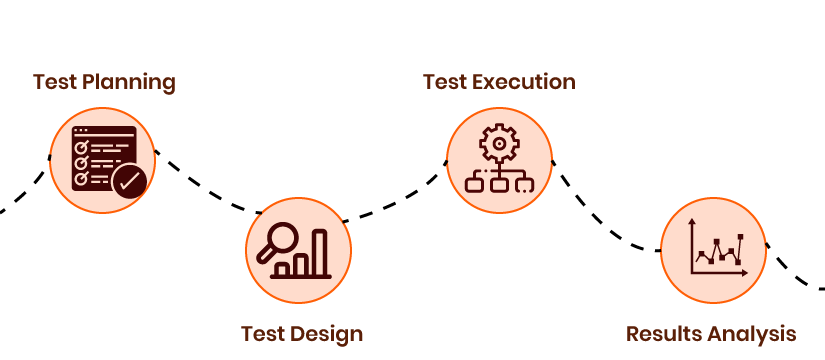
- Test planning: Test planning as in usual software testing life cycles specifies the major tasks, schedule, and resources for the testing process, which is the same for end-to-end testing also.
- Test design: Test design deals with test case generation, test specifications, usage analysis, risk analysis, and scheduling tests.
- Test execution: the actual test execution takes place in this step and the test results are documented.
- Results analysis: Test results are analyzed and compared here.
End to End Testing Process

- Analyze the testing requirements for testing
- Set up your test Environment and determine hardware/software requirements.
- Define the system and its subsystems procedures.
- Describe roles and responsibilities.
- Describe testing methodology and standards
- Track requirements and design test cases
- Create Input and output data for all the system and sub-systems involved
How to create End-to-End Test Cases?
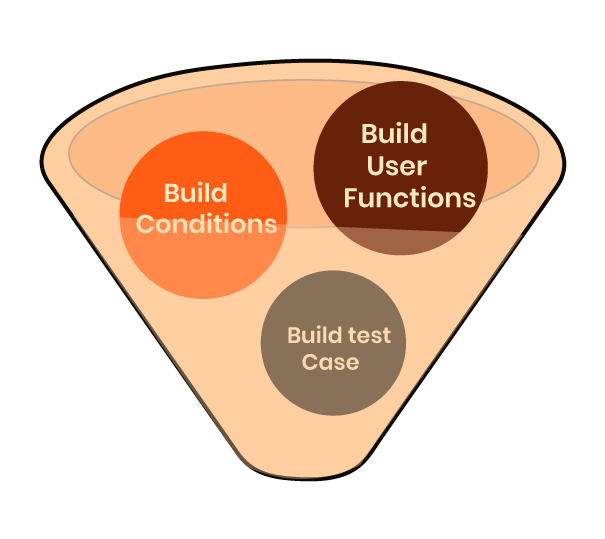
- Build user functions
- Build Conditions
- Build Test Cases
Build User Functions
Build user function includes the following activities:
- Make a list of system features and associated components
- Make a list of input data, action and the output data
- Determine the relationships among various functions
- Identify if the function is reusable or independent
Example of End-to-end Testing
Let us explain it with the help of an example of a banking system. Where you log in to your account and transfer the amount to another bank (3rd party sub-system)
- Login into your bank account
- Check the balance
- Transfer amount from your account to another bank account (3rd party sub-system)
- Check amount details after transfer
- Logout
Build Conditions based on User Function
Following activities are performed as a part of build conditions:
- For every defined function, build a set of conditions including timing, sequence, and data conditions
For example for
Login Page check for
- Incorrect User Name and Password
- Correct username and password
- Password strength
- Error messages
Build a Test Scenario
For the user function, build the test scenario
In this case, build test scenarios
- Login
- Checking bank balance amount
- Transferring the bank balance amount
Why is End to End Testing Important?
New software systems are very complex and have multiple subsystems. If any of these sub-systems fails. The complete software system could fail. This could be avoided by E2E testing.
It tests the entire system flow, increasing test coverage to multiple sub-systems. It detects issues with sub-systems and hence decreasing the chances of the whole system going corrupt because of the bug in any sub-system.

E2E testing tests all the layers of the software from front-end to the back-end, its interfaces, and final endpoints. It makes sure the software is tested both from users and real-world scenarios. It hence allows evading risks by
- Checking the complete flow of the software
- Increasing test coverage
- Detecting more issues
- increasing the total productivity of the software
Other Reasons For Performing End to End Testing are:
- Tests the Back-end
It helps in testing the back end of the software. as it is very evident that the functioning of the software depends on its back-end database. Hence testing this layer helps to identify how properly can the software perform its function.
- Identifies Errors in Diverse Environment
It helps to test, heterogeneous, distributed, cloud, and SOA-based environments. It also helps detect issues in multiple components of the software.
- Validates App Behavior over Multi-Tier Architecture & Systems
E2E testing helps in testing the behavior over Multi-Tier Architecture & Systems. It tests the complete functioning of connected systems.
- Ensures Correct Interaction & Experience
It makes sure that the software interacts properly and offers a smooth experience across various platforms and environments.
- Conducts Repeatable Tests at Different Points & Processes
End-to-end testing helps execute repeatable tests for various processes of software happening at multiple points of transactions.
It also validates complete software and sub-systems flow, enhancing the test coverage and trust in software performance.
Metrics For End to End Testing
- Test Case preparation status
- Weekly Test Progress
- Defects Status & Details
- Environment Availability
Difference Between End to End Testing Vs System Testing
|
E2E Testing |
System Testing |
| Tests the software including all its sub-systems. | Tests the software as per the requirement specification. |
| Tests end-to-end process flow. | Tests features and functionalities |
| Tests all interfaces, backend systems | Only Functional and Non-Functional Testing |
| It is done after system testing | It is done after Integration Testing. |
| Since it involves testing complex external interfaces that are difficult to automate, Manual Testing is generally chosen for E2E testing. | System testing can be conducted using both Manual and Automation |
End to End Testing Methods
There are two ways in which E2E testing can be conducted. Both give the same results, but based on their pre-requisites and advantages, we can choose the better method for our E2E testing needs.
Horizontal E2E testing
Horizontal E2E testing is largely preferred by the testers for their E2E testing needs. In horizontal E2E testing, we test every workflow through a discrete application from beginning to end to test if the workflow works perfectly fine.
Vertical E2E testing
Vertical E2E testing is used for critical modules of a complex system. It tests the systems in layers, in short, testing, is conducted in sequential, hierarchical order. It also tests the software from beginning to end for the all-inclusive testing.
End-to-End Testing Automation
E2E testing automation is similar to the automation of other types of testing. E2E testing automation helps in easy execution of test cases and then comparing and reporting and analyzing results. Automation does not require human intervention and is largely preferred for teat cases that require long hours to execute.
As the main aim of E2E testing is all-inclusive testing of the software from the beginning to end, automation testing helps in increasing test coverage and hence reducing the chances of defects.
E2E testing automation also helps in testing of software that are multilingual or requires a large amount of data.
Read also : 8 Website Testing Trends of 2020 You Need To Know!
It is possible to test the applications, which are multilingual with the help of E2E testing automation. Also, when the amount of data is in huge amount, it is preferable to take the help of E2E testing automation.
In short E2E, automation testing is no different from any other automation testing. But in the E2E testing when you have to test various complex external interfaces like sub-systems, integrations and backend databases, automation of E2E testing becomes very difficult and manual testing is preferred for E2E testing in such cases.
Framework For End to End Testing
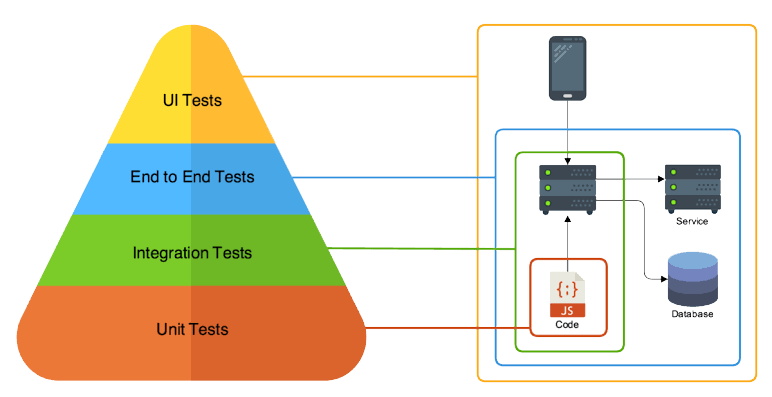
System and the subsystems testing
The system can be referred to as a functional unit of the system and it is connected to various sub-systems like databases. Interfaces, etc. in E2E testing we test for all of these frameworks. E2E after testing all the functional aspects of the system tests for the information being shared among the various peripherals of the system and also the proper working of various peripherals.
Vertical
Vertical E2E testing is used for critical modules of a complex system. It tests the systems in layers, in short, testing, is conducted in sequential, hierarchical order. It also tests the software from beginning to end for the all-inclusive testing.
Black box testing
Black box testing or behavioral testing, test the performance errors, input/output errors, terminating and initializing errors and functional errors. In black-box testing, the input is given and output is validated. It has nothing to do with the internal code.
White-box testing
The line by line testing of the code is referred to as white box testing. The testers are required to have good programming language skills for white box testing.
Horizontal
Horizontal E2E testing is largely preferred by the testers for their E2E testing needs. In horizontal E2E testing, we test every workflow through a discrete application from beginning to end to test if the workflow works perfectly fine.
Testing Tools For End to End Testing
Selenium and Protractor are two popular testing tools for E2E testing in web UI development. Cypress, TestCafe, and TestComplete are other prominent testing tools used.
Benefits of End to End Testing
#1. Ensures Complete Correctness of software
#2. Enhances Confidence in software
#3. Reduces Future Risks
#4. Decreases Repetitive Efforts
#5. Reduces Costs & Time
#6. Checks database as well as the back end layer of an application.
#7. Increases test coverage
#8. Different points of the software can be multiple times.
#9. App behavior in complex architecture can be put to the test
#10. Software interaction and UX can be measured
#11. Complicated apps can be divided into multiple tiers for testing.
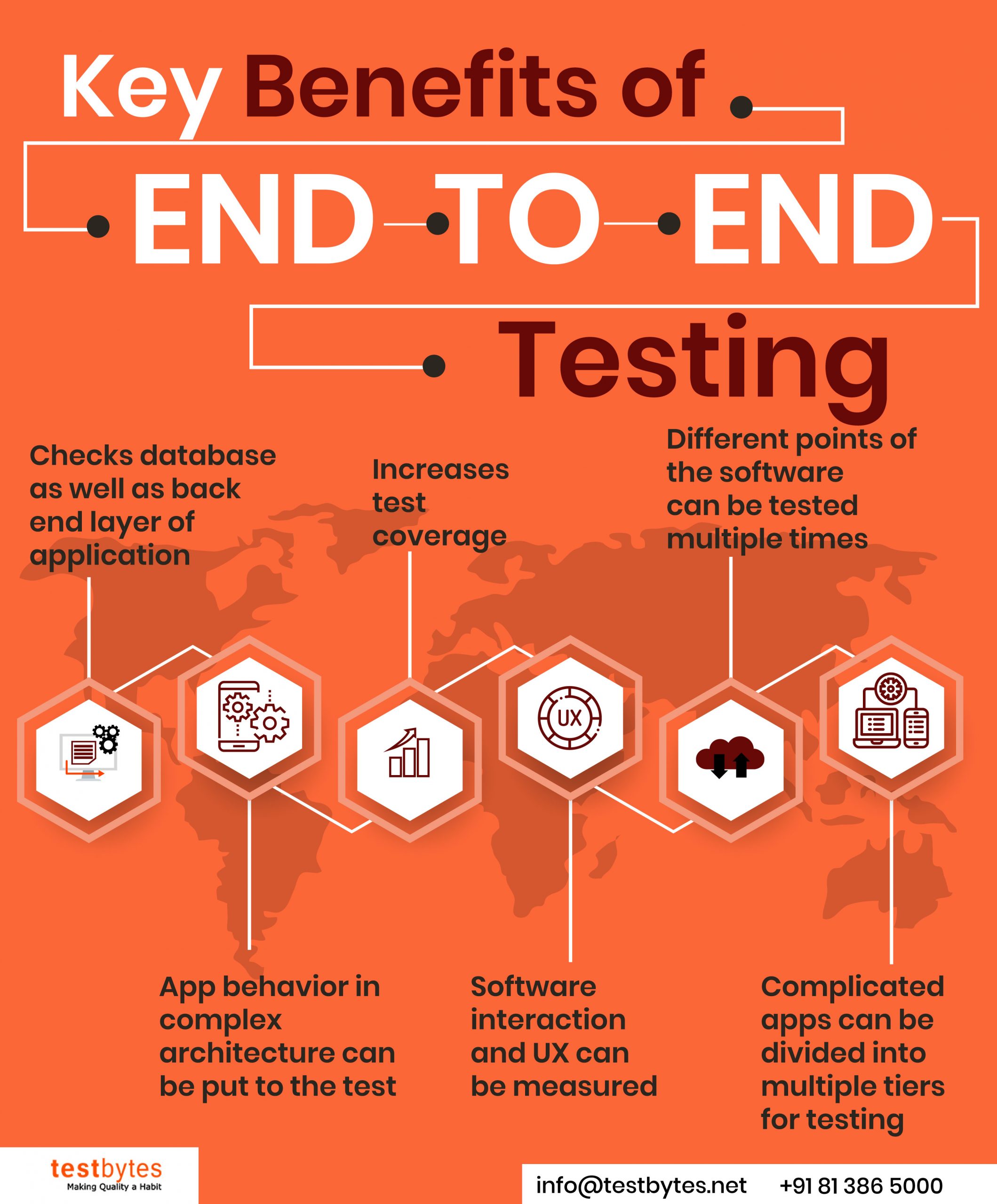
Conclusion
End to end testing verifies software system along with its sub-systems. It is conducted out after system and functional testing and ensures maximum risk detection. For these types of testing, you should have good knowledge of the complete system and interconnected sub-system.


 Software Testing Events
Software Testing Events App Testing
App Testing Web App Testing
Web App Testing Game Testing
Game Testing Automation Testing
Automation Testing Load Testing
Load Testing Security Testing
Security Testing Performance Testing
Performance Testing Hire a Tester
Hire a Tester





